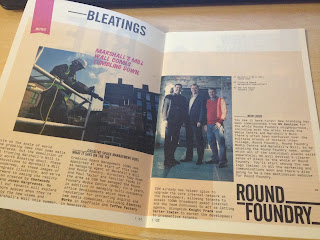|
BA (Hons.) GRAPHIC DESIGN
|
LEVEL
|
04
|
|
|
Module Code
|
OUGD402
|
|
|
|
Module Title
|
Personal
Professional Practice
|
||
|
|
|||
|
END OF MODULE SELF-EVALUATION
|
|
NAME
|
Luke
Rossiter
|
|
1. What skills have you developed through this
module and how effectively do you think you have applied them?
|
|||||
|
I have mainly gained a greater
appreciation of how large the field of graphic design is, and how many
branches and sub branches it has. For example, there is branding and identity
design, then logo design or business card design as braches of this. The
world of graphic design as a whole has really opened itself up to me. I have
also found dozens of new designers and websites that I can follow and gain
inspiration from in a variety of fields from poster design to information and
wayfinding. I have also learnt the basics for Indesign, a superb program that
has opened up publishing to me, something I have never really done before but
have based many major project on this year.
|
|||||
|
2. What approaches to/methods
of design production have you developed and how have they informed your
design development process?
|
|||||
|
Having learnt some new skills
in InDesign I have be producing many, many more publications. I have also
improved my skills in Indesign to level where I can help others when they are
stuck, especially when it comes to sending the files to print correctly and
adjusting large amounts of text.
With a greater knowledge of
the different classifications of design I have been able to be more sure
about what I want to produce, new areas of design that I had never considered
before have become areas I have great interest in, for example alternative
business card design.
|
|||||
|
3. What strengths can you
identify in your work and how have/will you capitalise on these?
|
|||||
|
Once again I have gained strength
in the technical aspect of design, I usually understand technology so I tend
be fairly proficient with the new software I am introduced too. In the future
I hope to move into a higher level of understanding in the three main design
tools provided by Adobe, especially Photoshop with has un unbelievable
learning curve.
|
|||||
|
4. What weaknesses can you
identify in your work and how will you address these in the future?
|
|||||
|
A weakness I have is lack or
urgency or speed. I am fairly good at getting tasks completed on time but I
always seem to spend twice as long and provide the same amount and quality of
work as me peers. This was something I discovered during some of the study
tasks when we were asked to evaluate ourselves as designers. I have also
developed a messed up balance between my social, work and domestic life, some
weeks I work too hard, other weeks I spend far too long socialising. The good
news is that next year I will have a house full of graphic designers, so they
will keep the same schedule as me instead of how things are at the moment;
where I am persuaded away from my work by my friends on less intense courses.
|
|||||
|
5. Identify five things that
you will do differently next time and what do you expect to gain from doing
these?
1)
Live with graphic
designers so my social life can be the same structure as them. This way we
can all work on projects at home as well as at college and dedicate similar
time slots to social and domestic activities.
2)
Spend a greater amount
of time caring for my PPP blog, it has been neglected compared to my context
and practice blogs. I feel that this will not happen next year as I believe
PPP takes up a bigger chunk of our time table.
3)
Work at posting more
work than is expected or set, I always realise that the more work I do the
better I will become at design. And the greater understanding I will have
into the principles of design.
4)
I will try to do more
personal work and post it to the blog, this ability to generate your own work
is something that the most respected designers practise so is something I
should do too.
5)
I would like to develop
a more personal style. At the moment I tend to find inspiration from book and
the Internet but I really don’t want to always conform to safe design styles.
If I can do this I believe that I will earn more respect as a designer and
have more confidence in my own creativity.
|
|||||
|
|
|||||
|
6.How would you grade yourself
on the following areas:
(please indicate using an
‘x’)
5= excellent, 4 = very good, 3
= good, 2 = average, 1 = poor
|
|||||
|
|
1
|
2
|
3
|
4
|
5
|
|
Attendance
|
|
|
|
|
x
|
|
Punctuality
|
|
|
|
|
x
|
|
Motivation
|
|
|
|
x
|
|
|
Commitment
|
|
|
x
|
|
|
|
Quantity of work produced
|
|
|
x
|
|
|
|
Quality of work produced
|
|
|
x
|
|
|
|
Contribution to the group
|
|
|
|
x
|
|
|
The evaluation of your work is
an important part of the assessment criteria and represents a percentage of
the overall grade. It is essential that you give yourself enough time to
complete your written evaluation fully and with appropriate depth and level
of self-reflection. If you have any questions relating to the self evaluation
process speak to a member of staff as soon as possible.
|
|||||




















































